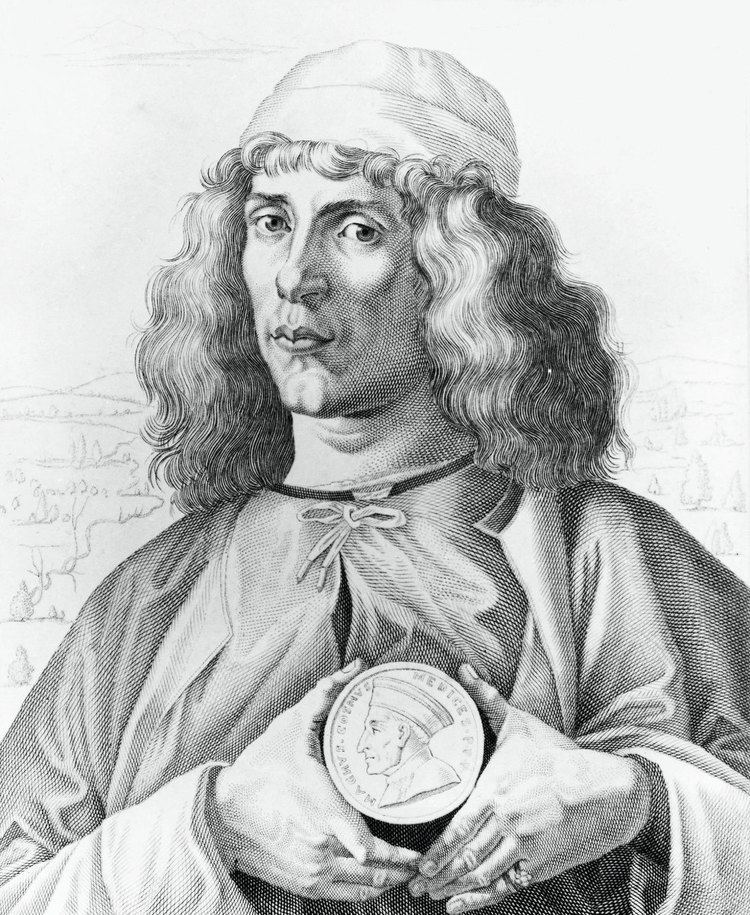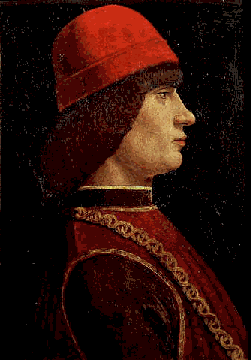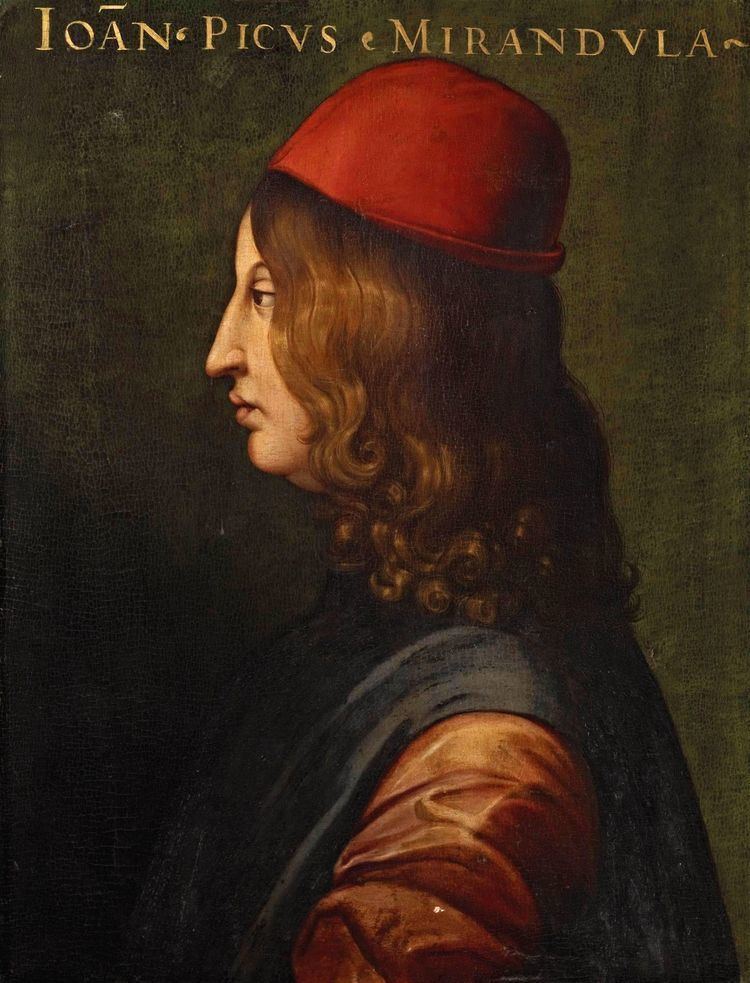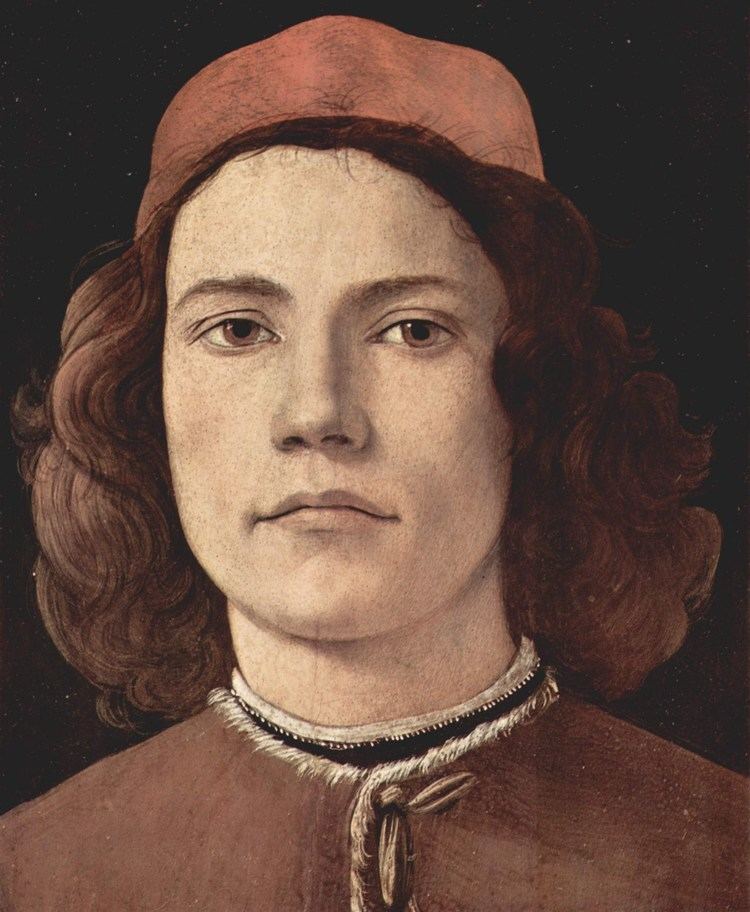Name Giovanni della | Region Western Philosophers | |
 | ||
Influenced by Similar People Marsilio Ficino, Poliziano, Plato, Lorenzo de' Medici, Thomas More | ||
Giovanni pico della mirandola oration on the dignity of men year 1486
Giovanni Pico della Mirandola ([dʒoˈvanni ˈpiːko della miˈrandola]; 24 February 1463 – 17 November 1494) was an Italian Renaissance nobleman and philosopher. He is famed for the events of 1486, when, at the age of 23, he proposed to defend 900 theses on religion, philosophy, natural philosophy, and magic against all comers, for which he wrote the Oration on the Dignity of Man, which has been called the "Manifesto of the Renaissance", and a key text of Renaissance humanism and of what has been called the "Hermetic Reformation".
Contents
- Giovanni pico della mirandola oration on the dignity of men year 1486
- What is Giovanni Pico della Mirandola Explain Giovanni Pico della Mirandola
- Family
- Education
- Florence
- Death
- Writings
- References

What is Giovanni Pico della Mirandola?, Explain Giovanni Pico della Mirandola
Family

Giovanni was born at Mirandola, near Modena, the youngest son of Gianfrancesco I Pico, Lord of Mirandola and Count of Concordia, by his wife Giulia, daughter of Feltrino Boiardo, Count of Scandiano. The family had long dwelt in the Castle of Mirandola (Duchy of Modena), which had become independent in the fourteenth century and had received in 1414 from the Holy Roman Emperor Sigismund the fief of Concordia. Mirandola was a small autonomous county (later, a duchy) in Emilia, near Ferrara. The Pico della Mirandola were closely related to the Sforza, Gonzaga and Este dynasties, and Giovanni's siblings wed the descendants of the hereditary rulers of Corsica, Ferrara, Bologna, and Forlì.

Born twenty-three years into his parents' marriage, Giovanni had two much older brothers, both of whom outlived him: Count Galeotto I continued the dynasty, while Antonio became a general in the Imperial army. The Pico family would reign as dukes until Mirandola, an ally of Louis XIV of France, was conquered by his rival, Joseph I, Holy Roman Emperor, in 1708 and annexed to Modena by Duke Rinaldo d'Este, the exiled male line becoming extinct in 1747.

Giovanni's maternal family was singularly distinguished in the arts and scholarship of the Italian Renaissance. His cousin and contemporary was the poet Matteo Maria Boiardo, who grew up under the influence of his own uncle, the Florentine patron of the arts and scholar-poet Tito Vespasiano Strozzi.
Education
A precocious child with an exceptional memory, Giovanni was schooled in Latin and possibly Greek at a very early age. Intended for the Church by his mother, he was named a papal protonotary (probably honorary) at the age of ten and in 1477 he went to Bologna to study canon law.
At the sudden death of his mother three years later, Pico renounced canon law and began to study philosophy at the University of Ferrara. During a brief trip to Florence, he met Angelo Poliziano, the courtly poet Girolamo Benivieni, and probably the young Dominican monk Girolamo Savonarola. For the rest of his life he remained very close friends with all three, including the ascetic and anti-humanist Savonarola. He may also have been a lover of Poliziano.
From 1480 to 1482, he continued his studies at the University of Padua, a major center of Aristotelianism in Italy. Already proficient in Latin and Greek, he studied Hebrew and Arabic in Padua with Elia del Medigo, a Jewish Averroist, and read Aramaic manuscripts with him as well. Del Medigo also translated Judaic manuscripts from Hebrew into Latin for Pico, as he would continue to do for a number of years. Pico also wrote sonnets in Latin and Italian which, because of the influence of Savonarola, he destroyed at the end of his life.
He spent the next four years either at home, or visiting humanist centres elsewhere in Italy. In 1485, he travelled to the University of Paris, the most important centre in Europe for scholastic philosophy and theology, and a hotbed of secular Averroism. It was probably in Paris that Giovanni began his 900 Theses and conceived the idea of defending them in public debate.
Florence
During this time two life-changing events occurred. The first was when he returned to settle for a time in Florence in November 1484 and met Lorenzo de' Medici and Marsilio Ficino. It was an astrologically auspicious day that Ficino had chosen to publish his translations of the works of Plato from Greek into Latin, under Lorenzo's enthusiastic patronage. Pico appears to have charmed both men, and despite Ficino's philosophical differences, he was convinced of their Saturnine affinity and the divine providence of his arrival. Lorenzo would support and protect Pico until his death in 1492. Without Lorenzo's support it is doubtful that Pico would have survived the Inquisition coming after him.
Soon after this stay in Florence, Pico was travelling on his way to Rome where he intended to publish his 900 Theses and prepare for a "congress" of scholars from all over Europe to debate them. Stopping in Arezzo he became embroiled in a love affair with the wife of one of Lorenzo de' Medici's cousins. It almost cost him his life. Giovanni attempted to run off with the woman, but he was caught, wounded and thrown into prison by her husband. He was released only upon the intervention of Lorenzo himself. The incident is wholly representative of Pico's often audacious temperament and of the loyalty and affection he nevertheless could inspire.
Pico spent several months in Perugia and nearby Fratta, recovering from his injuries. It was there, as he wrote to Ficino, that "divine Providence ... caused certain books to fall into my hands. They are Chaldean books ... of Esdras, of Zoroaster and of Melchior, oracles of the magi, which contain a brief and dry interpretation of Chaldean philosophy, but full of mystery." It was also in Perugia that Pico was introduced to the mystical Hebrew Kabbalah, which fascinated him, as did the late classical Hermetic writers, such as Hermes Trismegistus. The Kabbalah and Hermetica were thought in Pico's time to be as ancient as the Old Testament, and for that reason, he accorded them an almost scriptural status. It was always Pico's intention to walk completely around a topic and look at it from many possible angles, in order to derive the truest possible vision of the thing itself. syncretism, for Pico, was seeing the same absolute from many different points of view, a Scholastic approach with a strong modern resonance.
Pico based his ideas chiefly on Plato, as did his teacher, Marsilio Ficino, but retained a deep respect for Aristotle. Although he was a product of the studia humanitatis, Pico was constitutionally an eclectic, and in some respects he represented a reaction against the exaggerations of pure humanism, defending what he believed to be the best of the medieval and Islamic commentators, such as Averroes and Avicenna, on Aristotle in a famous long letter to Ermolao Barbaro in 1485. It was always Pico's aim to reconcile the schools of Plato and Aristotle, since he believed they used different words to express the same concepts. It was perhaps for this reason his friends called him "Princeps Concordiae", or "Prince of Harmony" (a pun on Prince of Concordia, one of his family's holdings). Similarly, Pico believed that an educated person should also study the Hebrew and Talmudic sources, and the Hermetics, because he believed they represented the same concept of God that is seen in the Old Testament, but in different words.
He finished his "Oration on the Dignity of Man" to accompany his 900 Theses and traveled to Rome to continue his plan to defend them. He had them published together December 1486 as "Conclusiones philosophicae, cabalasticae et theologicae", and offered to pay the expenses of any scholars who came to Rome to debate them publicly.
In February 1487, Pope Innocent VIII halted the proposed debate, and established a commission to review the orthodoxy of the 900 Theses. Although Pico answered the charges against them, thirteen of them were condemned. Pico agreed in writing to retract them, but he did not change his mind about their validity. He proceeded to write an apologia defending them, as Apologia J. Pici Mirandolani, Concordiae comitis, published in 1489, which he dedicated to his apparently very tolerant patron, Lorenzo. When the pope was apprised of the circulation of this manuscript, he set up an inquisitorial tribunal, forcing Pico to renounce the Apologia, in addition to his other condemned theses, which he agreed to do.
The pope declared 900 Theses to be:
In part heretical, in part the flower of heresy; several are scandalous and offensive to pious ears; most do nothing but reproduce the errors of pagan philosophers...others are capable of inflaming the impertinence of the Jews; a number of them, finally, under the pretext of 'natural philosophy', favor arts that are enemies to the Catholic faith and to the human race.
Pico fled to France in 1488, where he was arrested by Philip II, Duke of Savoy, at the demand of the papal nuncios, and imprisoned at Vincennes. Through the intercession of several Italian princes – all instigated by Lorenzo de' Medici – King Charles VIII had him released, and the pope was persuaded to allow Pico to move to Florence and to live under Lorenzo's protection. But he was not cleared of the papal censures and restrictions until 1493, after the accession of Alexander VI (Rodrigo Borgia) to the papacy.
Pico was deeply shaken by the experience. He reconciled with Savonarola, who remained a very close friend. It was at Pico's persuasion that Lorenzo invited Savonarola to Florence. But Pico never renounced his syncretist convictions.
He settled in a villa near Fiesole prepared for him by Lorenzo, where he wrote and published the Heptaplus id est de Dei creatoris opere (1489) and De Ente et Uno (Of Being and Unity, 1491). It was here that he also wrote his other most celebrated work, the Disputationes adversus astrologiam divinicatrium (Treatise Against Predictive astrology), which was not published until after his death. In it, Pico acidly condemned the deterministic practices of the astrologers of his day.
After the death of Lorenzo de' Medici, in 1492, Pico moved to Ferrara, although he continued to visit Florence. In Florence, political instability gave rise to the increasing influence of Savonarola, whose reactionary opposition to Renaissance expansion and style had already brought about conflict with the Medici family (they eventually were expelled from Florence) and would lead to the wholesale destruction of books and paintings. Nevertheless, Pico became a follower of Savonarola. Determined to become a monk, he dismissed his former interest in Egyptian and Chaldean texts, destroyed his own poetry and gave away his fortune.
Death
In 1494, Pico and his friend Angelo Poliziano were poisoned, under mysterious circumstances. It was rumored that his own secretary had poisoned him, because Pico had become too close to Savonarola. He was interred together with Girolamo Benivieni at San Marco and Savonarola delivered the funeral oration. Ficino wrote: "Our dear Pico left US on the same day that Charles VIII was entering Florence, and the tears of men of letters compensated for the joy of the people. Without the light brought by the king of France, Florence might perhaps have never seen a more somber day than that which extinguished Mirandola's light."
In 2007, the bodies of Poliziano and Pico della Mirandola were exhumed from St. Mark's Basilica in Florence. Scientists under the supervision of Giorgio Gruppioni, a professor of anthropology from Bologna, wished to use modern technology to determine the cause of the two men's death. In February 2008 they announced that these forensic tests showed that both Poliziano and Pico died of arsenic poisoning, probably at the order of Lorenzo's successor, Piero de' Medici.
Writings
In the Oratio de hominis dignitate (Oration on the Dignity of Man, 1486), Pico justified the importance of the human quest for knowledge within a Neoplatonic framework.
The Oration also served as an introduction to Pico's 900 theses, which he believed to provide a complete and sufficient basis for the discovery of all knowledge, and hence a model for mankind's ascent of the chain of being. The 900 Theses are a good example of humanist syncretism, because Pico combined Platonism, Neoplatonism, Aristotelianism, Hermeticism and Kabbalah. They also included 72 theses describing what Pico believed to be a complete system of physics.
Mirandola's De animae immortalitate (Paris, 1541), and other works, developed the doctrine that man's possession of an immortal soul freed him from the hierarchical stasis. Pico may have believed in universal reconciliation, since one of his 900 theses was "A mortal sin of finite duration is not deserving of eternal but only of temporal punishment;" it was among the theses pronounced heretical by Pope Innocent VIII in his bull of 4 August 1487. In the Oration he writes that "human vocation is a mystical vocation that has to be realized following a three stage way, which comprehends necessarily moral transformation, intellectual research and final perfection in the identity with the absolute reality. This paradigm is universal, because it can be retraced in every tradition."
A portion of his Disputationes adversus astrologiam divinatricem was published in Bologna after his death. In this book Pico presents arguments against the practice of Astrology that have had enormous resonance for centuries, up to our own time. Disputationes is influenced by the arguments against astrology espoused by one of his intellectual heroes, St. Augustine of Hippo, and also by the medieval philosophical tale Hayy Ibn-Yaqzan which promoted autodidacticism as a philosophical program. Pico's antagonism to astrology seems to derive mainly from the conflict of astrology with Christian notions of free will. But Pico's arguments moved beyond the objections of Ficino, who was himself an astrologer. The manuscript was edited for publication after Pico's death by his nephew Giovanni Francesco Pico della Mirandola, an ardent follower of Savonarola, and may possibly have been amended to be more forcefully critical. This might possibly explain the fact that Ficino championed the manuscript and enthusiastically endorsed it before its publication.
Pico's Heptaplus, a mystico-allegorical exposition of the creation according to the seven Biblical senses, elaborates on his idea that different religions and traditions describe the same God.
On Being and the one (Latin: De ente et uno), has explanations of several passages in Moses, Plato and Aristotle. It is an attempted reconciliation between Platonic and Aristotelian writings on the relative places of being and "the one" and a refutation of opposing arguments.
He wrote in Italian an imitation of Plato's Symposium. His letters (Aureae ad familiares epistolae, Paris, 1499) are important for the history of contemporary thought. The many editions of his entire works in the sixteenth century sufficiently prove his influence.
Another notorious text by Giovanni Pico della Mirandola is De omnibus rebus et de quibusdam aliis, "Of all things that exist and a little more" which is mentioned in some entries on Thomas More's Utopia and makes fun of the title of Lucretius' De rerum natura.
